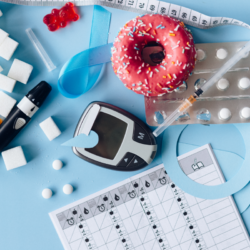The effective management of diabetes relies to a large extent on rigorous monitoring of carbohydrate intake. The aim of this article is to explore different methods of facilitating carbohydrate counting, which is essential for maintaining stable blood sugar levels in people with diabetes.
What are the different types of carbohydrate?
Carbohydrates are a category of fundamental macronutrients that provide metabolic energy to living organisms. Chemically, they are composed of carbon, hydrogen and oxygen. In the context of food, carbohydrates are classified mainly into three types: simple sugars, oligosaccharides and polysaccharides.
- Simple sugars: These carbohydrates are rapidly absorbed by the body and include glucose, fructose and galactose. Simple sugars are found in fruit, honey and added sugars.
- Oligosaccharides: These are made up of a few sugar units and are found in certain foods such as vegetables, legumes and milk. Lactose, a milk sugar, is a typical example.
- Polysaccharides: This group includes complex carbohydrates such as starch and dietary fibre, which take longer to break down and be used by the body. They are found in whole grain products, root vegetables and legumes.
Each type of carbohydrate has a different impact on metabolism and blood sugar regulation, which is particularly relevant for people with diabetes.
What impact do carbohydrates have on blood sugar levels?
The role of carbohydrates in diabetes management is crucial because of their direct impact on postprandial blood glucose levels (blood sugar levels after a meal). When carbohydrates are consumed, they are converted into glucose, leading to an increase in blood sugar levels. Individual glycaemic response can vary depending on a number of factors, such as:
- The nature of the carbohydrate: Complex carbohydrates are generally digested more slowly, resulting in a more gradual release of glucose into the bloodstream. This is beneficial for avoiding blood sugar spikes, which are a major challenge in managing diabetes.
- Fibre: Fibre-rich foods slow down the digestion of carbohydrates and reduce the impact on blood sugar levels. Soluble fibre, in particular, can also help improve insulin sensitivity.
- Cooking method: The way food is prepared can affect its glycaemic index (GI). For example, foods cooked for longer may have a higher GI than those that are cooked less or eaten raw.
- Food combinations: Eating carbohydrates with proteins or fats can also moderate the rate of glucose absorption and stabilise blood sugar levels.
Effective management of carbohydrate intake is therefore essential for people with diabetes, who often need to count carbohydrates to adjust their insulin dose and prevent extreme fluctuations in blood sugar levels. Using accurate carbohydrate counting methods and understanding how different types of carbohydrate affect blood glucose levels are fundamental skills for improving glycaemic control and maintaining optimal health.
What are the different carbohydrate calculation techniques?
A. Traditional measurement methods
Carbohydrate counting is an essential practice in diabetes management, enabling individuals to maintain optimal blood glucose control. Traditional methods of carbohydrate measurement include a number of manual and visual techniques that have been tried and tested over time.
- Measuring portions: Using standard measuring utensils such as measuring cups and spoons, carbohydrates in solid and liquid foods can be quantified. This method requires a good knowledge of recommended portion sizes and measurement equivalents.
- Reading food labels: Consulting the nutritional information provided on food packaging is crucial. Labels show the number of grams of carbohydrate per portion, making it easier to calculate the total carbohydrate intake of a meal or snack.
- Exchange guides: These guides, often used in meal plans for diabetics, allow you to substitute one food for another with a similar carbohydrate content. These tools help to diversify the diet while maintaining a constant carbohydrate intake.
These methods, while effective, can be tedious and error-prone without adequate training and practice. They require a clear understanding of food composition and the ability to accurately estimate food portions.
B. Use of modern technologies (applications and devices)
With the advance of technology, many digital tools have been developed to simplify carbohydrate calculation, making this task more accurate and less burdensome for people with diabetes.
- Mobile applications: Applications such as MyFitnessPal, Carbs & Cals, or Gluci-Chek offer an exhaustive database of foods with precise details of their carbohydrate content. These applications can often be used to scan product barcodes for instant nutritional information and to keep a daily food diary.
- Connected devices: Some electronic devices, such as smart food scales, can calculate carbohydrates directly from the food weighed. These devices often synchronise with mobile applications to provide a detailed analysis of daily nutrition.
- Connected watches and bracelets: Incorporating diet-tracking functions, these wearable devices can help monitor carbohydrate intake in real time, based on the user’s physical activity and eating habits.
The use of modern technology in carbohydrate calculation offers significant advantages in terms of convenience and accuracy, helping people with diabetes to manage their condition more independently and effectively. These modern tools not only support carbohydrate monitoring but also encourage a better understanding of the impact of different foods on blood glucose levels.
How can you decipher food labels to help calculate carbohydrates?
A. Details to look for on labels
Analysing food labels is crucial for people with diabetes who need to keep a close eye on their carbohydrate intake. In France, as in many other countries, nutritional information on packaging helps consumers to make informed food choices adapted to their medical condition.
- Total carbohydrate content: This is the first piece of information to check. It is generally expressed in grams for a given portion of food. This figure includes complex carbohydrates, simple sugars, fibre and sometimes polyols.
- Dietary fibre: Fibre is subtracted from total carbohydrates when calculating net carbohydrates, as it has less impact on blood sugar levels. In France, the fibre content is often indicated, allowing digestible carbohydrates to be deducted.
- Sugars: This value, included in the carbohydrate total, indicates the quantity of simple sugars present in the product. For diabetics, it is particularly important to monitor this value as simple sugars quickly affect blood sugar levels.
- Portion size: Nutritional information is calculated per portion. It is therefore essential to compare the portion size indicated on the packaging with the quantity actually consumed to avoid any error in calculating the carbohydrates ingested.
- List of ingredients: Ingredients are listed in descending order of quantity. This helps to identify products with added sugars or hidden carbohydrates, such as glucose syrup, fructose or other forms of sugar.
B. Practical exercises to help you understand labels
To reinforce your ability to use food label information effectively, here are a few practical exercises:
- Product comparison: Take two similar products and compare their labels. Identify the differences in terms of carbohydrate, fibre and sugar content. This can help you choose the most suitable option for effective diabetes management.
- Calculating net carbohydrate: Use the fibre information to calculate net carbohydrate (total carbohydrate minus fibre). This can be done by taking a standard portion of a product and subtracting the amount of fibre from the total amount of carbohydrate.
- Looking for hidden sugars: Examine the list of ingredients to identify added sugars under different names. This exercise helps you develop a better understanding of how sugars are incorporated into food products.
- Glycaemic impact assessment: After consuming a product, monitor your blood sugar levels to see how they react. This can reveal valuable information about how different foods affect your personal blood sugar levels.
By mastering these techniques, people with diabetes can improve their carbohydrate management and maintain tighter control of their blood sugar levels. These skills are essential for good therapeutic education of the diabetic patient, facilitating a better quality of life and reducing the risks associated with this chronic disease.
Implications of foods with a high glycaemic index
What are high GI foods?
The glycaemic index (GI) is a measure of how quickly carbohydrate-containing foods raise blood sugar levels after consumption. High GI foods are particularly important to identify for people with diabetes, as they can cause blood sugar spikes that are difficult to manage and potentially dangerous.
- Definition of high GI foods: A food is considered to have a high GI if its index is above 70 on the glycaemic index scale. These foods rapidly release glucose into the bloodstream, causing a rapid rise in blood sugar levels.
- Examples of high GI foods:
- Refined cereal products such as white bread, baguettes and certain types of pasta.
- Sweetened breakfast cereals.
- Sweet snacks such as certain biscuits and cakes.
- Sweetened drinks, including soft drinks and certain fruit drinks.
- Cooked potatoes, especially mashed or fried.
These foods should be identified and their consumption moderated to maintain an appropriate glycaemic balance.
How can we manage the impact of high GI foods?
Managing high-GI foods is crucial to controlling blood sugar levels and avoiding the long-term complications associated with diabetes, such as cardiovascular disease and neuropathy. Here are some strategies for managing the impact of these foods:
- Limiting consumption: It is advisable to limit the amount of high GI foods in the daily diet. Favouring low or moderate GI foods can help maintain more stable blood sugar levels.
- Combination with other macronutrients: When eating a high GI food is unavoidable, it is beneficial to combine it with proteins or healthy fats. These macronutrients slow down the digestion and absorption of carbohydrates, thereby reducing blood sugar spikes.
- Choosing low-GI alternatives: Replacing high-GI foods with low-GI alternatives can significantly reduce the impact on blood sugar levels. For example, choose wholemeal bread instead of white bread or opt for less refined cereals such as bulgur or quinoa.
- Food education and planning: In-depth dietetic education helps diabetic patients to better understand the impact of food choices on their health. Learning how to plan meals and read nutrition labels effectively are essential skills.
By integrating these practices into their daily diabetes management, individuals can significantly reduce the risk of blood sugar fluctuations and improve their overall health. Understanding the glycaemic index and its impact on blood glucose levels is therefore a key component of therapeutic education for people with diabetes.
The impact of fibre-based food supplements
In carbohydrate management, particularly for people with diabetes, the inclusion of fibre-based dietary supplements such as psyllium has shown significant benefits. Psyllium, derived from the seeds of the Plantago ovata plant, is particularly well known for its effectiveness in moderating glycaemia and improving insulin response.
- Role of psyllium in carbohydrate management:
- Reducing the glycaemic index of foods: Psyllium forms a viscous gel when it comes into contact with water. This gel slows down the process of digestion and absorption of carbohydrates, thereby reducing postprandial blood sugar peaks.
- Improved digestive health: In addition to its impact on blood sugar levels, psyllium promotes intestinal health and can help regulate transit, contributing to better overall carbohydrate management.
- Incorporating psyllium into the diet:
- Psyllium can be incorporated into the daily diet in powder or capsule form, often recommended to be taken with water before meals to maximise its effect on reducing carbohydrate absorption.
- It is essential to start with a small dose and increase gradually, as introducing psyllium too quickly can lead to side effects such as bloating or digestive problems.
Sources
- Nutr J. 2016; Soluble fibers from psyllium improve glycemic response and body weight among diabetes type 2 patients (randomized control trial)
- Am J Clin Nutr. 1999 Oct;Effects of psyllium on glucose and serum lipid responses in men with type 2 diabetes and hypercholesterolemia
- https://www.federationdesdiabetiques.org/





